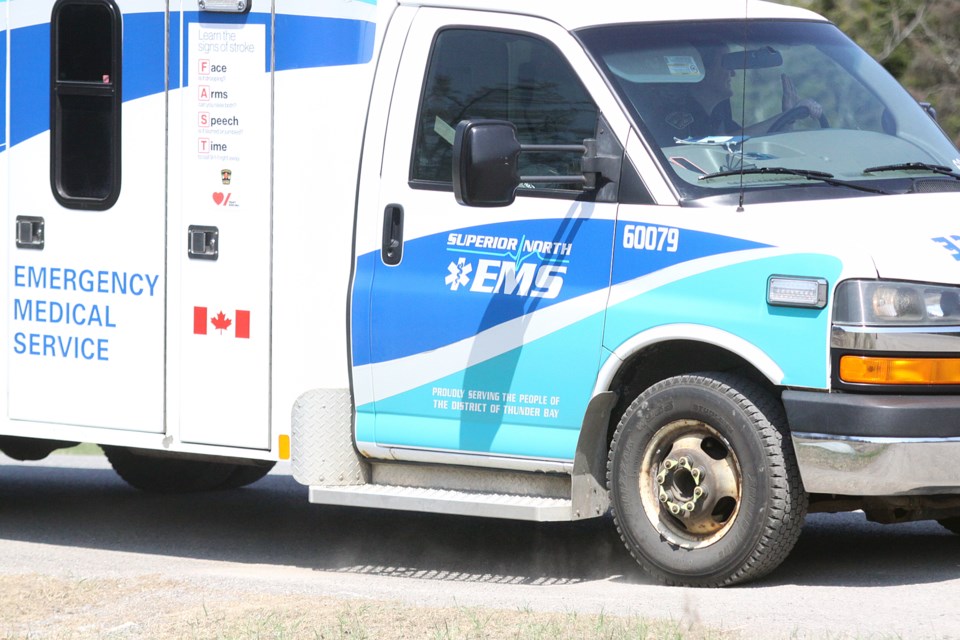THUNDER BAY — Municipal leaders in Superior North are continuing to express concerns about a plan to reduce the number of ambulance bases across the region.
Superior North EMS Chief Shane Muir gave a presentation at the Thunder Bay District Municipal League on Friday, providing an overview of the services call volume, staffing challenges, and an update on the implementation of its master plan.
During his presentation, Muir said that Superior North EMS call volumes for many municipalities have increased significantly in 2022. Among the areas with significant increases in call volumes were Greenstone, Nipigon and Red Rock, and Schreiber and Terrace Bay.
Last year, Thunder Bay city council approved the service's master plan, which includes consolidating ambulance stations in Nipgion and Red Rock as well as Schreiber and Terrace Bay, along with the closure of the base in Beardmore to redeploy its ambulance to Longlac.
Greenstone Coun. Eric Pietsch questioned Muir about the plan, asking about the impacts of closing the Beardmore base. He specifically mentioned a 164-kilometre strech of highway that would not have ambulance coverage.
“What you have spoken to today is we are seeing incremental increases in calls. Do you think that closing the Beardmore station was the best service you can provide to our community and to the traveller on that stretch of highway?” Pietsch asked.
Muir pointed to the plan to use its community paramedicine program to continue having personnel in Beardmore, but said "without a doubt" that closing the station was for the best for the service, given its staffing challenges and rising call volume.
“Looking at the statistics, yes that is the move we had to make and why we had to do that is because looking at the utilization of that base it is well below the three per cent range," Muir said.
"When we have utilization in the 90 per cent range in some regions, we know we could take those resources and move them to be better used elsewhere and actually take some pressures off other areas that have a much higher call volume."
Muir added that the service doesn't have the paramedic staff to keep the station open, but have “bulked up” their staffing in Geraldton and Longlac to have multiple shifts covering 24 hours.
“We do not have the paramedics in place. We are attempting to staff it the best we can, but in reality, we have to move to where those resources are needed the most,” Muir said.
In an interview afterwards, Muir said the existing facilities are not adequate for a modern paramedic service.
Pietsch acknowledged the resource and staffing challenges, as well as the use of the community paramedicine program, but noted that Muir's presentation showed Greenstone had a high rate of emergency calls.
“Greenstone has the highest amount of level four calls out and level four calls coming back, which means they were actually responding to a lights and sirens call within our community and actually having to do those protocols, so I think introducing a program district-wide is fantastic," Pietsch said.
Mark Figliomeni, the CAO, clerk and treasurer for Red Rock, said he did not feel like there was been sufficient consultation in the process.
"We do understand that there are changes coming, but we want to make sure they are changes that reflect service levels in the district as well as the city," Figliomeni said. "We understand there are serious issues throughout the city and district, and we want to be a part of the discussions that enable essential services to happen and continue to happen or happen at a better level than they already are within the city and the district.
Figliomeni also took issue with the process of having Thunder Bay city council making decisions that affect other municipalities across the district. Other parts of Northwestern Ontario have land ambulance services overseen by district services boards.
"I certainly understand what happens at the council level and how those councillors have to vote, or did vote on that situation," he said. "I think there has to be a better model to serve us all. We gather together and one of the big statements we make at a conference like this is that the city needs the region, and the region needs the city to survive."
